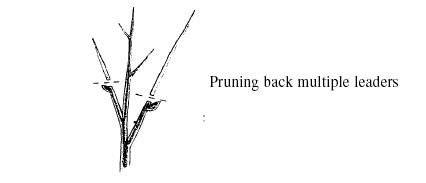A Guide to Successful Pruning, Pruning Evergreen Trees
ID
430-457 (SPES-402P)
EXPERT REVIEWED
Anatomy of an Evergreen Tree
Evergreen trees have leaves that persist year-round, and include most conifers and some broad-leaved trees. Evergreen trees generally need less pruning than deciduous trees.
Conifers are distinguished from other plants by their needle or scale-like leaves, and their seed-bearing cones. Because conifers have dominant leaders, young trees rarely require training-type pruning. The leader is the vertical stem at the top of the trunk. If a young tree has two leaders, prune one out to prevent multiple leader development. Selective branch removal is generally unnecessary as evergreens tend to have wide angles of attachment to the trunk.

Evergreens are grouped on the basis of their branch arrangement. Pines, spruces, and firs have whorled branches that form a circular pattern around the growing tip. The annual growth of a whorl- branched conifer is determined by the number of shoots that are pre-formed in the buds. Whorl-branched conifers usually have only one flush of growth each year in which these pre-formed shoots expand into stems that form the next whorl.

The second group of evergreens are those with a random branching habit. Yew, arborvitae, cedar, false cypress, and juniper are all random-branched species.
What to Prune
Corrective pruning for evergreen trees consists mainly of dead, diseased, or damaged branch removal. Remove dead wood promptly, by cutting dead branches back to healthy branches. When pruning diseased branches, make thinning cuts into healthy wood, well below the infected area. Thinning cuts remove branches back to their points of origin or attachment. Disinfect tools between each cut with products such as “Lysol,” “Listerine,” or rubbing alcohol. Tests have shown that “Pine-Sol” and household bleach are highly corrosive to metal tools.

Allow evergreen trees to grow in their natural form. Don't prune into the inactive center (no needles or leaves attached) of whorl-branched conifers because new branches won't form to conceal the stubs.
When a tree's leader is lost due to storm damage or disease, replace it by splinting to a vertical position the upper lateral on the highest branch. Prune all laterals immediately below the new leader. Use wood or flexible wire splints, removing them after one growing season.

How to Prune
Do not prune branches flush to the trunk. Flush cutting is harmful in several ways: it damages bark as pruning tools rub against the trunk, it removes the branch collar, and it goes behind the branch bark ridge. The branch collar is the swollen area of trunk tissue that forms around the base of a branch. The branch bark ridge is a line of rough bark running from the branch-trunk crotch into the trunk bark, less prominent on some trees than on others.
The best pruning cut is made outside the branch collar, at a 45 to 60 degree angle to the branch bark ridge. Leave the branch collar intact to quickly heal the wound and help prevent decay from entering the trunk.
Whenever removing branches greater than one inch in diameter, use the three-cut method to avoid tearing bark. First, about 12 inches from the trunk, cut halfway through the limb from the underside. Second, about 1 inch past the first cut, cut through the limb from the top side. The limb’s weight will cause it to break between the two cuts. Make the third cut outside the branch collar, as described in Publication 430-456.

Don’t coat pruning cuts with tree paint or wound dressing. Coatings won’t prevent decay or promote wound closure, and may actually prevent wounds from healing.
Pines and other whorl-branched conifers become denser if new growing tips (“candles”) are pinched in half as they expand in the spring. Pinch by hand, as pruning shears will cut the expanding needles and leave them with brown tips.

When to Prune
Most evergreen pruning is done for corrective reasons, so seasonal timing is not as important as it is for deciduous species. Pruning during dormancy is the most common practice and will result in a vigorous burst of spring growth. Whenever unexpected damage from vandalism or bad weather occurs, prune immediately.
There are, however, certain evergreen pruning activities for specific times of the year. Prune random-branched conifers in early spring when new growth will cover the pruning wounds. “Candles” of whorl-branched conifers should be pinched back in mid to late spring. Maintenance pruning of random-branched conifers is done in summer to keep plants within a desired size range. Remove spent flowers of evergreen magnolias at the end of their blooming season to stimulate new growth and development of a thicker crown. During the winter, minor pruning for decorating purposes usually causes no harm.
Whenever possible, avoid pruning evergreen trees in late summer and early fall. Pruning at this time can stimulate new growth that may not harden off before winter, and thus may be damaged or killed by the cold, For more detailed information, see VCE Publication 430-462, Evergreen Tree Pruning Calendar.
Virginia Cooperative Extension materials are available for public use, reprint, or citation without further permission, provided the use includes credit to the author and to Virginia Cooperative Extension, Virginia Tech, and Virginia State University.
Virginia Cooperative Extension is a partnership of Virginia Tech, Virginia State University, the U.S. Department of Agriculture (USDA), and local governments, and is an equal opportunity employer. For the full non-discrimination statement, please visit ext.vt.edu/accessibility.
Publication Date
May 17, 2022



